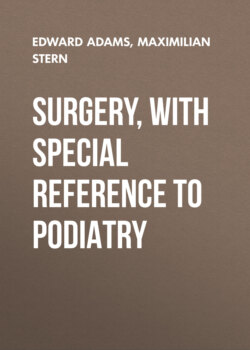Читать книгу Surgery, with Special Reference to Podiatry - Maximilian Stern - Страница 5
На сайте Литреса книга снята с продажи.
INTRODUCTION
ОглавлениеTable of Contents
Surgery, in contradistinction to medicine, as a separate branch of the healing art, includes all manual procedures and is not limited to cutting operations exclusively. It is that branch which deals with the treatment of morbid conditions by means of manual or instrumental agencies.
Morbid conditions include three distinct classes: those due to
1. Injuries
2. Infections
3. Diseases
Injuries. To this class belong all the processes due to physical agencies and it includes besides traumatism, the effects of heat and cold, of chemicals, of light and of electricity.
Infections. These may be either local or general. The reaction might occur at the point of entrance of the bacteria, or constitutional symptoms may evidence their invasion into the blood, or the absorption of their toxic products.
Many conditions in this class are linked closely with those in the following class:
Diseases. Here are classified (a) new growths, both benign and malignant; (b) changes due to age and environment, and (c) diseases not belonging in either of the above classes. These latter are generally known as idiopathic or spontaneous in their etiology. These terms, however, often indicate only a limit of knowledge as to their true etiology.
The Tissues. The tissues of the body, though apparently so different and varying so decidedly in their functions, are in many respects similar.
Every tissue is composed of two parts: the cellular elements and the intercellular substance. These are called cells and stroma. Upon the first of these depends the vitality and function of the part, while its density, shape and general physical properties are determined by the second. Likewise along the same lines of reason, all of our organs have two separate areas of tissue: the parenchymatous and the interstitial. The first contains the functioning and the second the supporting elements.
The physical conditions of the interstitial tissue or the intercellular substance vary greatly in density. Blood is a tissue, the intercellular constituent of which is fluid, and as we consider more dense tissues, we encounter all degrees of density of the framework or intercellular substance, until with the additional presence of calcareous elements, we conceive the hardness of bone and dentine. Tissues as a whole, however, are not solid; there are spaces in the supporting structure to admit of the passage of arteries, veins, nerves, and lymphatics.
Abnormal conditions arise in the various parts of the tissues. Certain diseases affect the parenchymatous tissue in an organ more than the interstitial tissue and again others affect the blood vessels particularly.
There may be hypertrophy, in which the entire organ or part becomes larger as a whole, the active cells and stroma sharing alike in the process, or there may be an hyperplasia, in which the active cells of the part proliferate abnormally. When the interstitial tissue alone develops excessively it is known as an infiltration. Under such circumstances the parenchymatous cells often undergo what is termed pressure atrophy; they are diminished by squeezing.
Atrophy of the part or organ, from whatever source, signifies its diminution in size; its function is, of course, either impaired or suspended as the process goes on.
The efforts on the part of the organism as a whole to combat or repair injury, bacterial invasion and disease are directed along definite lines. The study of these functions does not rightly come within the scope of these pages, belonging to physiology, but must be considered here, if only in brief for the purpose of a good understanding of the processes at work in surgical conditions.
As surgeons, the functions which concern us most are the
1. Nervous
2. Circulatory
3. Lymphatic
